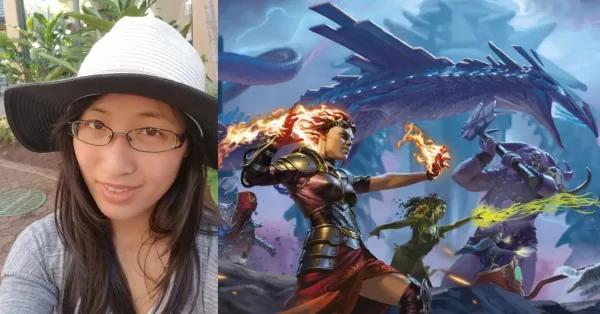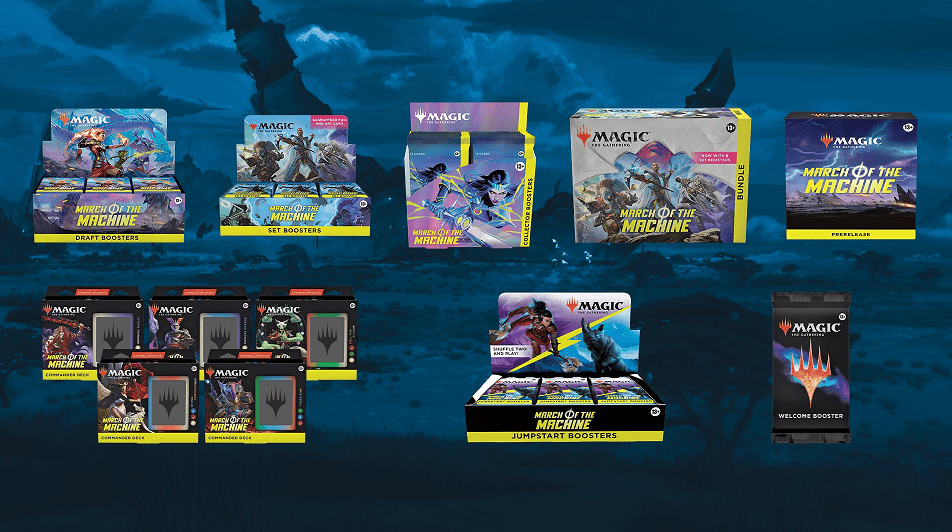Interview: Emily Teng, game designer and world building lead for March of the Machine
We recently got to interview to Emily Teng, Magic: The Gathering’s art game designer and world-building lead for March of the Machine.

Magic: The Gathering’s latest set – March of the Machine sees the conclusion of the Phyrexian story arc and with it, we got some very epic (not to mention, unexpected) team-ups and sprawling battles that takes place across MTG’s rich multiverse.
With all that interesting lore and brand-new mechanics coming from MOM, there’s got to be someone behind the scenes at Wizards of the Coast having the time of her life in creating all this awesomeness for the fans to dive in, right?
We recently got the opportunity to interview to Emily Teng, Magic: The Gathering’s art game designer and world-building lead for March of the Machine. Here’s what she had to say about the creation of the set, as well as all things in between for our favorite collectible card game! You might want to read on as there are some interesting pointers regarding game design for those who are aspiring to create their own lore and mechanics.
- March of the Machine lets players experience the new “”Battle”” cards involving iconic planes spanning across the multiverse. I can imagine the team having fun in revisiting these well-known locations but what were the challenges involved in creating this set from both a world-building and game mechanics perspective?
My role on the set was as worldbuilding lead, which means for battles my focus was on making sure we were hitting the creative flavor of each individual plane on a Battle card. It was a very exciting task, but definitely challenging on a number of fronts. One of the biggest challenges was actually deciding which planes would fit into what color identities. We knew early on that we wanted to showcase the invasion on as many planes as possible. In this, we were helped out by the fact that Magic has a ton of existing planes to draw from, not just planes that have been the settings for our premier sets, but also planes we might have only seen in ancillary sets, or even just on a single card or story mention. From there it became something of a jigsaw puzzle, trying to puzzle out which planes went where. We actually found it easier to lock down the color identity for a lot of these smaller, less-developed planes first, since they’d been created along narrow conceits that slotted more readily into one or two particular colors—for example Regatha was a slam dunk as a R Battle, thanks to Keral Keep. For more fleshed-out worlds, it was more of a guessing game, because there were so many different creative directions we could have leaned on to highlight. To decide, sometimes we leaned into a unique mechanical direction heavily associated with that plane, or an important story moment that we wanted to highlight. We’d create the back side of the Battle based on that, then extrapolate the associated color(s) that aligned to it.
Part of this challenge also came from the fact that we weren’t creating any new worldbuilding developments. Instead, we focused on magnifying pre-existing lore. We’re already ranging so broadly across the Multiverse, and making so many deep cuts, that we weren’t trying to invent new lore to layer on top of all that.”
2. I love what you did with the legendary team-ups! What went through the process on who should pair up with who?
The process was somewhat similar to how we approached Battles, in that we were essentially jigsawing what team-ups from which planes appeared in which color identities. The set has 15 “major” planes, which we focused more of the card set on, and we knew early on we wanted to see one team-up from each of those planes in the main set. After that, it was a collaborative process between worldbuilding and set design to figure out who were the legends we wanted to showcase. We focused on characters that we thought would have the greatest appeal. Some of the team-ups were driven by set design being interested in doing mechanical riffs on certain characters. Some of them were driven by worldbuilding wanting to highlight or push a particular legend or other.
The fun part of the process for me was when we’d nailed down the team-ups and then were able to start figuring out how to show them on art. We really leaned into what made each team-up unique—there was no one-size-fits-all template or “standard” team-up. For example, how would we visually get across the flavor of two lifetime foes teaming up (for the moment at least) against a larger threat? How could we capture and emphasize drastic size differences between, say, a tiny homunculus and a big brawling cyclops? If you’ve got two spellcasters, how do you show off their magics in a way that complements and enhances both? This is when, for me at least, the team-ups really came alive.
3. The next set of questions are more directed in wanting to know you both as a designer and enthusiast of the game. How has Magic: The Gathering made an impact in your life?
One thing that’s made a huge impression on me is the nonlinear delivery of lore. I started playing Magic in high school, and up until then, my exposure to fantasy worldbuilding was through novels and video games where you followed the game’s story from start to finish. Playing Magic was the first time I’d really seen worldbuilding packaged and presented not as a linear narrative, but as unconnected story and lore in art and flavor text that it’s then up to you to assemble to get a holistic picture of the world. It really opened my mind to different ways of worldbuilding than I’d thought about before.
4. What is your overall favorite Magic: The Gathering card and why?
It’s really hard to have one single favorite card. When talking favorites I automatically gravitate to art over mechanics or playability, which means I’m constantly changing what I consider are my favorites as new sets get released and new art is revealed. If I had to pick one at this moment in time, I’d say Discover the Impossible from NEO, by Ryan Pancoast. The quiet stillness of that piece, especially in contrast to the splashiness and high energy of the rest of the set, really make it stand out for me.
5. Lastly, the 5 colors are an integral part to both Magic: The Gathering’s game and story. What color or colors would you say you identify with the most?
Blue has always appealed to me the most, with its focus on intellect and knowledge. I read voraciously and I’m always trying to learn and absorb absolutely everything I can, because you never know when some stray snippet of information will come in handy. Also, I like the cleverness and tricksiness of blue!
‘March of the Machine’ Pre-release and official release date
Pre-release events will start of from April 14 to April 20, with an official release at your friendly local games stores on April 21.
‘March of the Machine’ will be available in the regular 16-card Draft Boosters, Set Boosters, Collector Boosters, 5 Commander Decks that feature a unique “Planechase” cards that adds new locations to the popular variant.
Additionally, along with welcome packs, Jumpstart boosters for March of the Machine will also be available as their way of easing the entry to newer players.
As paper Magic is coming back into full swing, it is greatly encouraged to head out to your FLGS. You can use this handy store locator to find a place that handles Magic: The Gathering near you, observing health protocols, of course.
Again, a big thank you to Wizards of the Coast and Emily Teng for this interview!
Related Links:
Interview: Ovidio Cartagena, creative content developer for Magic: The Gathering
Magic: The Gathering store locator
Magic: The Gathering ‘March of the Machine’ card preview – Omen Hawker


